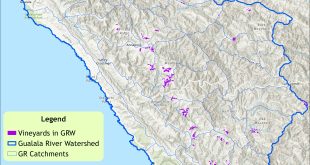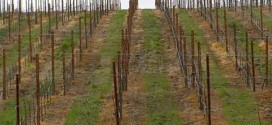Reactive Regulation or Affirmative Land Use Planning?
Vineyard Conversions and
the Fate of Coastal California Forestlands
Peter Baye, John Holland, and Chris Poehlmann,
Friends of the Gualala River
February 16, 2006
The rising popularity and prestige of Pinot Noir wine is causing unprecedented and rapid changes of land use in Sonoma and Mendocino Counties. For the first time, traditional forestry and ranching in coastal mountains are being displaced by intensive agriculture. Sonoma County is now proposing new regulation of vineyard conversions in coastal forestlands, where the pressure for conversions has been most intense.
Entrepreneurs intent on capitalizing on this market trend have arrived in Sonoma’s coastal forests with plans to deforest the ridge tops and plant vineyards. Last year more timber conversion applications were filed with the California Department of Forestry than in the last 10 years. The scale of proposed vineyard conversions ranges from a few tens of acres, to massive projects approaching 2,000 acres. Despite the unprecedented proposed scope of land use change in the region affected, no county or state agency has initiated either land use planning or analysis efforts to deal with it.
Each vineyard proponent so far has pointed to the small individual size of their projects relative to the remaining forest land in the county (applying the impermissible “Ratio Approach” to cumulative impacts analysis) to argue their claim of no environmental impacts from their project. The lead CEQA agency for forest-vineyard conversion, California Department of Forestry (CDF) has casually adopted this invalid piecemealed cumulative impact perspective in its CEQA documents, and these have failed to withstand recent legal challenge. CDF has not required any true landscape-scale, geographic analysis of vineyard conversions in the Gualala River watershed, where most conversions are proposed.
Sonoma County is updating its General Plan, and is considering broad land use zoning restrictions on vineyard conversion in forestland. But as the regulatory language of a proposed conversion ordinance evolved, it degenerated from forest protection into a nominal “no net loss” compensatory mitigation system for vineyard conversion with no geographic land use planning component whatever. It instead erected the foundations of a quid pro quo mitigated permit process for forest-to-vineyard conversions. No natural resource experts, land use planning experts, state resource agencies (even trustee agencies) were consulted in the formulation of the ordinance.
This forest “no net loss” policy suggests a possible trend of a routine permit process for vineyard conversions based on mitigation that relies on the practice of restoration forestry. The nature of mitigation and restoration, particularly of coastal forests in this region, should be given a hard look before they are accepted as a routine permit process.
The premise of the “no net loss” compensatory mitigation in the proposed ordinance is that “preserving” and “restoring” the timberland on two thirds of a development property would effectively mitigate for all direct, indirect, and cumulative impacts of agricultural conversion within large, unbroken tracts of forestland. There was no analysis of the effects of forest fragmentation, indirect effects of intensive agriculture, expansion of roads, or growth-inducing effects. How would these cumulative and indirect impacts be mitigated by a compensatory “no net loss” mitigation scheme? This defective approach is entirely lacking in a watershed or landscape analysis, and is in fact a recipe for irreversible and significant forest fragmentation.
It is noteworthy that Sonoma County asserts that the mitigation program of the ordinance is exempt from CEQA and its requirement for rigorous analysis of cumulative and indirect impacts. The unprecedented and massive scope of vineyard conversions proposed, and the cursory mitigation proposed without any impact analysis all, are symptoms of the CEQA vacuum created by the County’s position on CEQA exemption. Exempt or not, the County should instead use CEQA affirmatively as an integrative land use planning and regulatory tool, with the assistance of resource agencies, qualified scientists, and land use planning professionals.
Mitigation in most environmental laws, policies, and regulations, including CEQA, has a very different emphasis from that of “no net loss”. Mitigation in law (particularly NEPA and CEQA) generally treats compensation as a last resort. Mitigation in law stresses first finding ways to avoid and minimize harm to the environment. Compensation for impacts generally applies only after they are reduced to an unavoidable minimum. This conservative standard mitigation approach places much greater priority on protection of existing natural resources, and less on attempts to replicate them to compensate for their loss. Emphasis on minimization of impacts is not popular with most project proponents, since it usually means looking at ways to reduce the project size or configuration, diminishing profitability.
Permit agencies can’t do business on the basis of compensatory mitigation if they recognize all the scientific uncertainties about ecological restoration. They have to assume that restoration of habitats will in fact achieve what they promise and predict. Much commercial mitigation relies on ecological restoration measures that are essentially big, long-term experiments with limited control and monitoring. Almost all we know about “restoration” of redwood forests, for example, comes from legacies of very recent improvements in forest practices.
Proponents of mitigation have a vested interest in emphasizing or “selling” the promises of ecological benefits they can finance with “restoration forestry”, and a similar interest in downplaying or denying the ability of forests to recover on their own. A rigorous, critical scientific evaluation of restoration forestry proposals is needed before “forest restoration” becomes a standard currency for mitigation of escalating vineyard conversions. We also need sound scientific evaluation of how well natural forest regeneration, in the absence of short-rotation timber harvests, is contributing towards recovery of forest habitats before we assume that “restoration” is necessary and appropriate.
Will the emphasis on compensatory mitigation for vineyard conversions make land use planning and cumulative impact assessment moot issues? Will that emphasis also drown out discussion of the primary goals of mitigation – namely, avoiding and minimizing impacts through scientifically sound environmental analysis and affirmative land use planning? And will this discussion be dominated by proponents of development and permit agencies, or by the public and independent experts of scientific review panels?
Vigilant public participation will be essential to ensure that political and regulatory decisions about vineyard conversion, and its mitigation, are fully informed by rigorous public interest review, and scientific scrutiny.
| A version of this article appears in Northern News, published by the Northern Section, California Chapter of the American Planning Association |
 Friends of Gualala River Protecting the Gualala River watershed and the species living within it
Friends of Gualala River Protecting the Gualala River watershed and the species living within it


